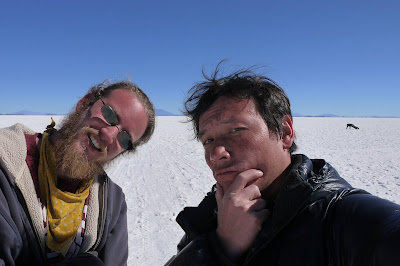Correction on yesterday´s post. The border town we arrived at on the
Argentinian side is actually called La Quiaca. Only when you cross the bridge and get your passport stamped are you officially in Villazon, Bolivia. This was easier for the Irish, Swiss and German passports than the American one which is beng discriminated against almost everywhere it goes in South America on the grounds of 'reciprocation'. You make life difficult for our travellers, we´ll do the same for yours.
 |
| One of my better headlines. |
 |
| You are now entering Bolivia. |
I was slightly disappointed they didn´t even ask for my yellow fever certificate which I took so much trouble getting in Hong Kong. For Noah, they demanded everything - yellow fever, typhoid, photocopy of passport photo plus US$135 in American dollars. Any bank note that had even a slight rip in it was considered counterfeit.
 |
| The other side, eventually. |
Like Shenzhen in China, the town of Villazon is best passed through as quickly as you possibly can. Our first port of call was the holiday town of Tupiza, famed for being the place where Butch Cassidy and the Sundance Kid wrecked havoc and, eventually, met their deaths against the Bolivian army. Even though the distance wasn´t far by South American standards we decided to take the express bus which promised to get us there in just two hours.

The journey cost 50 Bolivianos per person, which is to say, 50 HK dollars. In other words, 1 Boliviano equals 1 HK dollar. I found this, and continue to find this, one of the best things about Bolivia, because there is no need to do any maths. Lord knows how much money I spent in Chile because the currency there works in multiples of thousands. Here, I know from just looking at a menu that a pizza costs HK$25-30. A large bottle of beer in a touristy restaurant, HK$15. A bottle of Bolivian sauvignan blanc, HK$20-35. My full set of laundry, HK$10. A night at Tupiza´s most expensive and quite nice 3-starred Hotel Mitru, HK$60.
It is incredibly cheap here. This is why Bolivia has become the new Thailand for posh-but-apparently-penniless Bristish public school GAP year students. Hoards of them - Marlborough, Sevenoaks, you name it - hogging the internet centres skyping with mummy and daddy, asking to top up their bank accounts because they owe Robbie 3.50 beer money from the night before, but other than that, everything is "yeah, really really good, I´m having a really really good time".
Which brings me to the world's most annoying couple who I've been meaning to forget but now it's come right back. For two whole hours, they sat next to my Internet booth while I was carefully crafting my blog, she sobbing like a pathetic wet flannel because she couldn't get skype to work, and he cwith his arm around her, consoling her in that most creepy and unnatural way when you have an 18 year old rugger bugger going out with a 12 year old. Nothing aggravates me more than middle England abroad, and they are here in numbers.
Then there are the Israelis, freshly released from national service, tanned, cliquey, murderous-looking, but not altogether unpleasant, except to each other. It´s a language thing, according to Thora and Rahel, whereby "could you pass the wine please" sounds like "I´m going to decaptitate your whole family".
The Irish were also here, but not in wolf packs like the Israelis or rugby teams like the English. They usually travel in pairs, a lot of them couples. You often see the same couple in various different towns because they are genuinely here to travel, as opposed to getting drunk in one spot. There were also the scandinavians but I couldn´t find anything to say about Lars and Sven.
Thankfully, just as we were beginning to get comfortable with this scene, Noah put his foot down and insisted we get on with what we all came here for, a 6-hour high-altitude, tyre-shredding bus ride north to the town of Uyuni.



























































